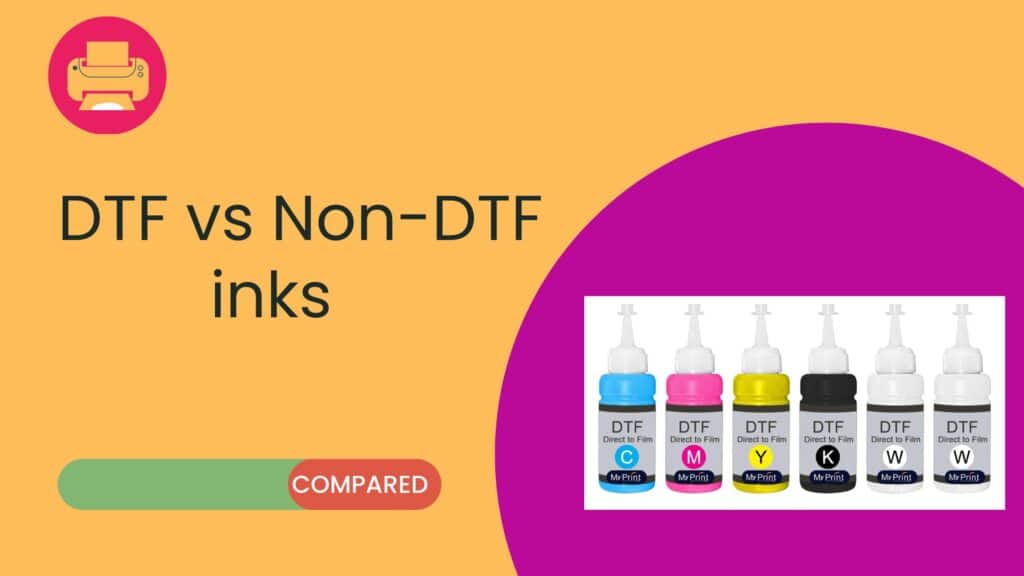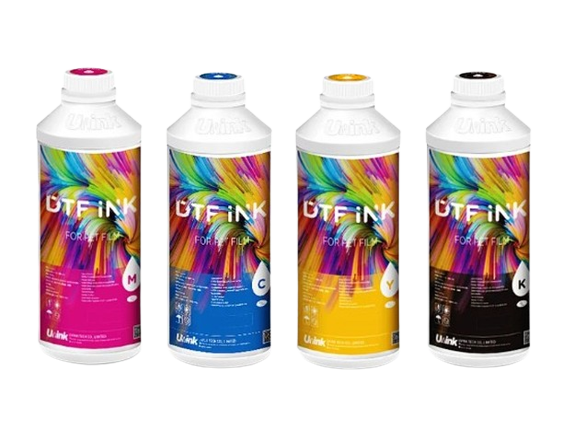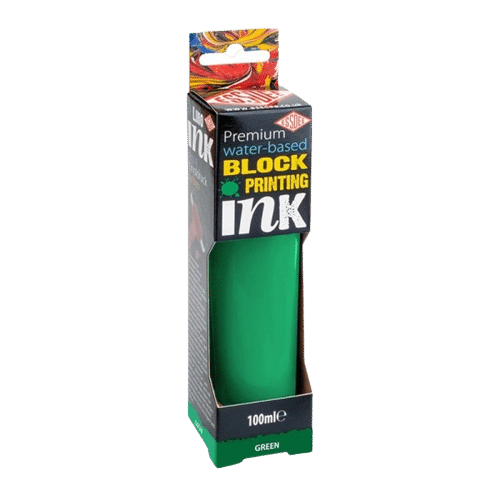The allure of counterfeit ink looms large in the exciting world of DTF printing. It’s a tempting possibility that offers affordability that’s difficult to refuse. But, my fellow DTF enthusiasts, there’s a twist in this tale.
In this blog post, we dive deep into the consequences of using the non-genuine ink. So, stay tuned as we unravel the tale of DTF printing with non-genuine ink and reveal why genuine ink may be the hero your prints deserve.

Non-Genuine Ink vs. Genuine DTF Inks
| Aspect | Non-Genuine Ink | Genuine Ink |
|---|---|---|
| Formulation | Lack specific DTF optimization. | Engineered for DTF technology. |
| Print Quality | Variable, may lack color accuracy. | Exceptional color accuracy, vibrancy. |
| Durability | Prone to fading, poor washability. | Highly durable, resistant to fading. |
| Compatibility | Cause printer issues, damage in the long run. | Compatible with DTF printing systems. |
| Consistency | Inconsistent quality. | Consistent quality and performance. |
| Cost | Lower upfront cost. | May have a slightly higher upfront cost. |
| Long-Term Cost | Potential higher long-term costs. | Potential long-term cost savings. |
| Customer Satisfaction | Risk of dissatisfaction. | Higher customer satisfaction. |
| Warranty and Support | May void printer warranties. | Often comes with manufacturer support. |
The Problems Arising from Non-Genuine Inks
Non-genuine ink in DTF (Direct-to-Film) printing can cause a slew of issues and challenges for businesses in this industry. This section discusses the risks of using fake DTF inks:
Fading and Color Distortion:
- Genuine ink often has better pigments and more consistent colors than non-genuine ink.
- Because counterfeit ink has less UV resilience than real ink, prints generated with it are more prone to fade over time.
- Unsatisfactory outcomes could result from sacrificing color accuracy and brightness.
Reduced Adhesion and Washability:
- Genuine ink can adhere to surfaces more strongly than counterfeit ink.
- Prints that are exposed to water or laundry can exhibit poor washability, resulting in color bleeding and distortion.
- Inferior adhesion can result in prints peeling or cracking prematurely.
Printer Damage and Maintenance Issues:
- The use of counterfeit ink can endanger the printer itself.
- Print heads that are clogged by low-quality ink might require to be repaired or replaced at a high expense.
- When you use non-original ink, printer warranties become void & null, leaving companies accountable for repair expenses.
Inconsistent Print Quality:
- Non-authentic ink might cause batch-to-batch print quality issues.
- Maintaining a consistent brand image and quality standard can be challenging for some businesses.
- Due to ink variances, you might need frequent adjustments and recalibrations.
Customer Dissatisfaction:
- Non-authentic ink might cause client displeasure.
- Customers could get poor prints that fall short of their expectations for quality and sturdiness.
- This might hurt a firm’s reputation and reduce recurring and referral business.
Increased Costs Over Time:
- While initially seeming to be more affordable, using counterfeit ink might result in rising expenditures.
- Due to increased ink usage, reprints, and printer maintenance, businesses may incur higher expenses.
- Additionally, the necessity for more regular printer replacements is quite expensive.
DTF inks vs Non-DTF inks
The two different types of printing inks, DTF inks and non-DTF inks, are each designed for certain printing processes and purposes. Here, we’ll examine the key differences between these two categories of inks.
DTF Inks
DTF inks are designed particularly for Direct-to-Film printing technique, which is often used to produce vivid, high-quality prints on a variety of textiles and surfaces. The key characteristics of DTF inks include:
DTF inks are made to stick to a heat-resistant film, which is then transferred to the intended substrate, such as textiles or clothing. This film holds the ink and makes it possible to print clearly and precisely.

They can handle the stretch and elasticity of materials, which makes them perfect for printing on textiles and garments. Even after several washings and uses, they retain their brilliant colors and stickiness.
DTF inks are renowned for their outstanding brightness and color fidelity. They are appropriate for complex designs and graphics because they create crisp, detailed prints with a broad color spectrum.
They keep their quality over time since they are resistant to fading, cracking, and peeling.
| Image | Product | Features | Price |
|---|---|---|---|
FOR EPSON PRINTERS  | CenDale Premium DTF Ink 600ML
| 9.9 | Check on AmazonGet 1200ml Pack |
ALL DTF PRINTERS  | Welacer DTF Ink Premium 6x100ml
| 9.8 | Check on Amazon10% Coupon |
AMAZON’S CHOICE  | Enlite DTF Ink 250ML Combo Pack
| 9.6 | Check on AmazonGet 500ml Pack |
WATERPROOF  | LOTSA. STYLE Premium DTF Ink
| 9.5 | Check on Amazon |
EPSON PRINTERS REFILL  | Greenland Office DTF Ink Premium 600ml
| 9.3 | Check on Amazon10% Coupon |
FOR ALL DTF PRINTERS  | Jecqbor DTF Transfer Ink
| 8.9 | Check on Amazon25% Coupon |
Non-DTF Inks
Non-DTF inks are a larger classification of printing inks used in a variety of printing processes, such as offset, digital, sublimation, screen, and more. These inks are used in a variety of applications and are not especially made for DTF printing. Features of non-DTF inks include:
Non-DTF inks are adaptable and can be utilized in a variety of printing processes, including conventional offset and screen printing as well as digital printing techniques.

Depending on the type of ink, they are made to work with a variety of substrates, such as paper, cardboard, plastic, and more. Depending on the kind of ink and the substrate, non-DTF inks might require various tshirt printing techniques, such as heat curing, air drying, or UV curing.
The substrate and ink type affect how long non-DTF prints will last. It’s possible that certain non-DTF prints won’t be as flexible or resilient as DTF prints on textiles.
Why should we always use DTF inks for DTF printing instead of other non-genuine inks?
We recommend DTF (Direct-to-Film) inks for numerous reasons:
Optimized Formulation:
- DTF inks are especially designed to meet the particular needs of DTF printing process. They are designed to function perfectly with the heat transfer onto films and fabrics procedure.
- DTF inks’ chemical composition guarantees optimal adhesion, color accuracy, and longevity on a range of fabric types.
Vivid and True Colors:
DTF inks are known for their exceptional color accuracy and vibrancy. They provide vivid, accurate colors that are perfect for re-creating complicated and detailed artwork.
Durability:
Genuine DTF inks used in DTF prints result in very durable prints. They are suited for textile and garment applications because they retain their quality and color fidelity even after repeated washing and wearing.
Consistency and Compatibility
- The compatibility of DTF inks with DTF printing tools and procedures is guaranteed. This lowers the possibility of technical problems and cuts down on downtime.
- Genuine DTF inks ensure that each print fulfills the required requirements by providing consistent quality from batch to batch.

Warranty and Support:
When you use authentic DTF inks, all DTF printer manufacturers provide warranties and technical assistance for their products. Using fake inks voids warranties.
Long-Term Cost Savings:
While DTF inks may initially cost a little more than counterfeit inks, their improved performance and extended lifespan can result in long-term cost benefits. Over time, non-genuine inks can increase reprints, ink consumption, and printer maintenance, which can be costly.
Customer satisfaction and reputation
- Genuine DTF inks are more likely to generate DTF prints that are of a caliber and durability that meet or surpass client expectations.
- Delivering high-quality DTF prints on a regular basis can help develop an excellent track record, client loyalty, and repeat business.
Switching ink in DTF Printers
In a DTF printer, changing ink is a simple procedure. Follow these methods to switch from counterfeit ink to real ink:
- Put the Printer in Storage Mode: Open the storage or flushing mode on the printer. This efficiently cleans the printer’s ink system of any leftover ink.
- Disinfect the Ink System: Any traces of the counterfeit ink will be removed by the printer’s flushing operation. This ensures a blank canvas for the fresh ink.
- Re-Fill with Genuine Inks: Refill the ink system with authentic DTF inks once it has been flushed. Make sure you use the correct ink cartridges and install the printer in accordance with the manufacturer’s instructions.
- Initiate Printer Calibration: It’s advised to do a printer calibration or nozzle check after refilling with authentic inks to make sure the new inks are flowing properly and achieving the required print quality.
Conclusion
In conclusion, the research of DTF printing using counterfeit ink has shown its risks and challenges. Although the temptation of low cost could entice, the trade-off in print quality & robustness make it a dangerous path.
Genuine DTF inks emerge as the hero, offering vibrant, consistent results, customer satisfaction, and long-term savings. The conclusion is unambiguous: genuine ink is the only option for individuals who want the finest in DTF printing and are not willing to compromise for less.
FAQs
The Direct-to-Film (DTF) printing process requires specially formulated inks called DTF inks. Because they are developed for adhesion, color accuracy, and durability on a variety of materials, they are crucial for DTF printing because they produce prints of a high caliber that can resist washing and usage.
While non-genuine inks might at first appear more affordable, they often result in long-term expenditures because of problems with print quality, reprints, and even printer damage. Genuine DTF inks are often more cost-effective in the long term, although being somewhat more costly initially.
Authentic DTF inks often function perfectly with certain DTF printer types. For best results, it’s essential to make sure the ink is compatible with the printer model you’re using.
Using counterfeit inks might expose users to legal concerns such as violation of intellectual property rights and counterfeiting. To prevent legal repercussions, it is essential to only purchase ink from reputable, approved vendors.
Seek for reliable manufacturers, seek for product certificates, and read customer reviews and testimonials to confirm the validity of genuine DTF inks and suppliers. Having a relationship with a reliable provider is essential for making sure your ink is genuine.
You can switch your printer from using non-genuine ink to using genuine DTF ink. Place the printer in storage mode to remove the old ink before adding new authentic DTF ink. To ensure a seamless transition, adhere to the manufacturer’s instructions.
Genuine DTF inks provide accurate color, brilliant prints, durability, compatibility with DTF printing devices, manufacturer warranties, and long-term cost savings. They guarantee reliable, high-caliber results that exceed client expectations.

Ashley Wang is a skilled sales manager with knowledge in DTF printing. She presently works for ShenLan Digital, a reputable DTF printer maker. Ashley is the best person to offer advice on selecting the most suitable DTF printer because she has tested a lot of them. She launched DTFPrinterSchool to educate individuals and organizations about DTF printing technology, providing her expertise and observations on the most recent advancements in the sector. Ashley is an invaluable resource for businesses and individuals wishing to invest in DTF printing technology because of her expertise and experience in the industry.
